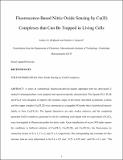| dc.contributor.author | McQuade, Lindsey E. | |
| dc.contributor.author | Lippard, Stephen J. | |
| dc.date.accessioned | 2011-12-14T20:58:12Z | |
| dc.date.available | 2011-12-14T20:58:12Z | |
| dc.date.issued | 2010-08 | |
| dc.date.submitted | 2010-04 | |
| dc.identifier.issn | 0020-1669 | |
| dc.identifier.issn | 1520-510X | |
| dc.identifier.uri | http://hdl.handle.net/1721.1/67684 | |
| dc.description.abstract | A series of symmetrical, fluorescein-derived ligands appended with two derivatized 2-methyl-8-aminoquinolines were prepared and spectroscopically characterized. The ligands FL2, FL2E, and FL2A were designed to improve the dynamic range of previously described asymmetric systems, and the copper complex Cu2(FL2E) was constructed as a trappable NO probe that is hydrolyzed intracellularly to form Cu2(FL2A). The ligands themselves are only weakly emissive, and the completely quenched Cu(II) complexes, generated in situ by combining each ligand with 2 equiv of CuCl2, were investigated as fluorescent probes for nitric oxide. Upon introduction of excess NO under anaerobic conditions to buffered solutions of Cu2(FL2), Cu2(FL2E), and Cu2(FL2A), the fluorescence increased by factors of 23 ± 3, 17 ± 2, and 27 ± 3, respectively. The corresponding rate constants for fluorescence turn-on were determined to be 0.4 ± 0.2, 0.35 ± 0.05, and 0.6 ± 0.1 min−1. The probes are highly specific for NO over other biologically relevant reactive oxygen and nitrogen species, as well as Zn(II), the metal ion for which similar probes were designed to detect. | en_US |
| dc.description.sponsorship | National Science Foundation (U.S.) (grant CHE-0907905) | en_US |
| dc.language.iso | en_US | |
| dc.publisher | American Chemical Society | en_US |
| dc.relation.isversionof | http://dx.doi.org/10.1021/ic100802q | en_US |
| dc.rights | Article is made available in accordance with the publisher's policy and may be subject to US copyright law. Please refer to the publisher's site for terms of use. | en_US |
| dc.source | Prof. Lippard via Erja Kajosalo | en_US |
| dc.title | Fluorescence-Based Nitric Oxide Sensing by Cu(II) Complexes That Can Be Trapped in Living Cells | en_US |
| dc.type | Article | en_US |
| dc.identifier.citation | McQuade, Lindsey E., and Stephen J. Lippard. “Fluorescence-Based Nitric Oxide Sensing by Cu(II) Complexes That Can Be Trapped in Living Cells.” Inorganic Chemistry 49.16 (2010): 7464-7471. | en_US |
| dc.contributor.department | Massachusetts Institute of Technology. Department of Chemistry | en_US |
| dc.contributor.approver | Lippard, Stephen J. | |
| dc.contributor.mitauthor | Lippard, Stephen J. | |
| dc.contributor.mitauthor | McQuade, Lindsey E. | |
| dc.relation.journal | Inorganic Chemistry | en_US |
| dc.eprint.version | Author's final manuscript | en_US |
| dc.type.uri | http://purl.org/eprint/type/JournalArticle | en_US |
| eprint.status | http://purl.org/eprint/status/PeerReviewed | en_US |
| dspace.orderedauthors | McQuade, Lindsey E.; Lippard, Stephen J. | en |
| dc.identifier.orcid | https://orcid.org/0000-0002-2693-4982 | |
| mit.license | PUBLISHER_POLICY | en_US |
| mit.metadata.status | Complete | |
